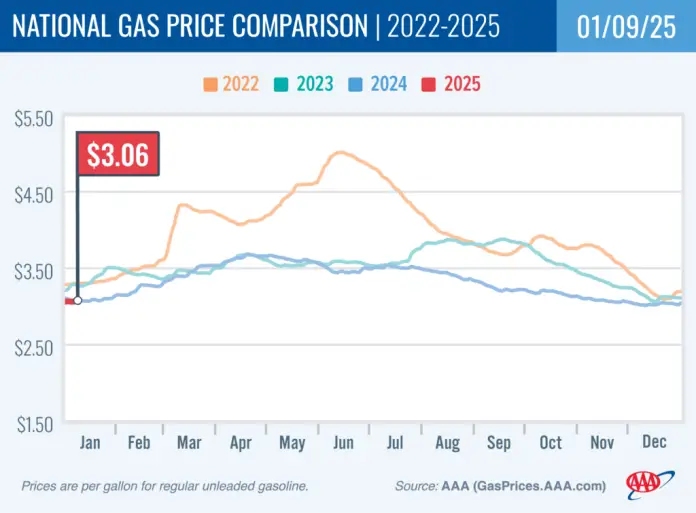As the start of 2025 unfolds, fuel prices remain a critical area of focus for small business owners across the United States. With the national average for a gallon of gas holding steady at $3.06, and electric vehicle (EV) charging rates maintaining a consistent 34 cents per kilowatt hour, the data presents both opportunities and challenges that local businesses must navigate in the months to come.
Andrew Gross, a spokesperson for AAA, provided insight into fuel price trends. “Looking back at 2024, the high point for the national average was $3.67 on May 19, and the low was $3.01 on December 10,” he noted. This data points to a period of volatility that small business owners should prepare for, as gas prices are expected to fluctuate slightly over the next couple of months following seasonal norms.
According to the latest updates from the Energy Information Administration (EIA), gasoline demand has seen a notable rise, increasing from 8.16 million barrels per day (b/d) to 8.48 million b/d. This spike in demand comes alongside a boost in domestic gasoline stocks, up from 231.4 million barrels to 237.7 million barrels. However, gasoline production has dipped to an average of 8.9 million b/d, signaling a potential for future price increases if the supply remains constrained.
For small businesses that rely heavily on transportation—be it delivery services, sales representatives, or commuting employees—these trends can significantly impact operating costs. The retail price for regular-grade gasoline averaged $3.30 per gallon throughout 2024, which is an improvement of 21 cents compared to 2023. Businesses will need to monitor these shifts closely as any increase in fuel prices could quickly translate to higher operational expenses.
Moreover, the EIA emphasizes the unprecedented crude oil production from the U.S., which averaged 12.9 million b/d in 2023. This figure not only broke previous U.S. records but also positioned the country as a leading producer globally. “The 2023 oil production record is unlikely to be broken by another country anytime soon,” noted the EIA. For small business owners, this can mean stability in supply but requires vigilance regarding price fluctuations that might stem from international market dynamics.
Small business owners should also be aware of the electric vehicle landscape. With charging station prices averaging 34 cents per kilowatt hour—unchanged for nearly five months—companies with EV fleets may find it essential to evaluate their electric costs amidst fluctuating gas prices. Efficiently managing fuel and charging expenses can lead to significant savings for businesses transitioning to or incorporating electric vehicles into their operations.
As businesses make decisions about transportation methods, understanding regional pricing disparities becomes vital. For example, the most expensive gasoline markets include Hawaii ($4.53), California ($4.38), and Washington ($3.90), while states like Oklahoma ($2.60) and Mississippi ($2.62) offer the least expensive options. This regional variation can have a substantial impact on delivery costs and overall business margins, particularly for companies operating across state lines.
Real-time updates on fuel and charging prices can greatly assist business owners in navigating these changes. The AAA TripTik Travel planner provides valuable resources, allowing users to easily find current gas and electric charging prices along their travel routes.
Managing fuel expenses is a key concern for small business owners as we progress into 2025. While current gas prices are stable, the elevated demand and production levels indicate that price fluctuations could arise soon. Business owners should develop strategies to mitigate fuel costs, potentially incorporating more energy-efficient practices or investing in electric vehicle technology to capitalize on the relatively stable electric rates.
With vigilance and proactive planning, small businesses can leverage the current landscape to not only survive but thrive amidst the various challenges presented by fluctuating fuel markets. For more detailed information, refer to the original post at AAA’s Gas Prices.


